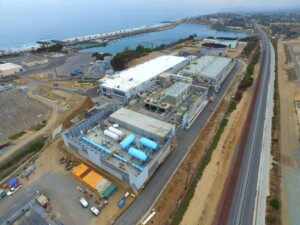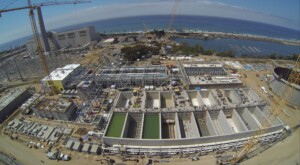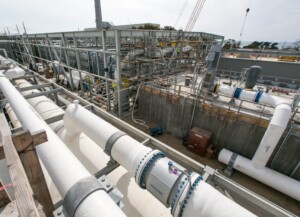Challenge
To serve a growing population in an area often stricken by drought, San Diego County Water Authority (SDCWA) began investigating the potential for a desalination project along the county’s coastline, eventually identifying the Carlsbad site due to the existing seawater intake and discharge infrastructure (serving Encina Power Station), as well as proximity to the regional distribution system. SDCWA then engaged developer Poseidon Water to design and construct a plant and conveyance pipeline as part of a 30-year Water Purchase Agreement for up to 56,000 acre-feet per year—or approx. 18.25 billion gallons.
Approach
Poseidon Water selected fixed-price design-build delivery to obtain performance-based guarantees on water quality, quantity, power consumption, and chemical usage while delivering a reliable water source in the shortest time frame. The RFP contained certain prescriptive requirements based on early permitting, but performance-based specifications allowed teams to develop innovative technical solutions. In particular, Poseidon encouraged ideas for reducing power consumption, chemical usage, and operating costs while improving the useful life of process components.
Based on a best-value selection process, Poseidon chose design-build team Kiewit Infrastructure West, Co. (Kiewit) and J.F. Shea Construction, Inc. (Kiewit Shea Desalination or “KSD”) and issued a contract requiring delivery in just 36 months. They included pre-established performance conditions, mitigation, monitoring, and reporting requirements, and regulatory and environmental restrictions and approvals.
KSD subcontracted with IDE Technologies for the process design of reverse osmosis and instrumentation and controls systems. Arcadis was balance-of-plant designer and engineer of record. Arcadis completed structural, mechanical, architectural, hydraulic, corrosion control, and electrical design, including structures, equipment, piping at the intake pump station, pre-treatment, microfiltration, reverse osmosis, post-treatment, solids handling, chemical feed/storage, product water storage and product water pump station process areas. Pipeline design was by Tetra Tech; pipeline construction by J.F. Shea.
The project scope included design, engineering, procurement, construction, and commissioning for the desalination facility (pretreatment system, reverse osmosis process, post-treatment, pump station, and tie-ins to the existing intake and discharge systems); 10 miles of 54-inch, high-pressure, steel conveyance pipeline; and upgrades to existing SDCWA facilities for distributing desalinated seawater.
The KSD and Arcadis team added value during each phase of the project—from fostering a collaborative team environment and co-locating key team members during the design and construction phases of the project to continually challenging the “status quo” design or construction approaches. Each team member delivered added value elements based on the unique experience and expertise that they possessed.
Results
The team employed design-build best practices such as equitably balanced risk assessment, clear expectations for communication and problem solving, and co-location to accelerate design completion, allowing early procurement of specialized equipment. Vital stakeholder communication, including familiarizing permitting agencies with the desalination process to facilitate review, helped secure completion on schedule. The KSD design-build team helped Poseidon save $25 million through value engineering: reducing process pipe by rearranging site layout; reducing equipment by maximizing gravity flow post-treatment; reducing concrete by minimizing holding tank volumes; and optimizing piping, mechanical, and electrical and structure sizes to reduce scope and quantities.
When completed in December 2015, the $592 million Claude “Bud” Lewis Carlsbad Desalination Plant became the largest seawater reverse osmosis (SWRO) desalination plant in the Western Hemisphere, taking in up to 108 million gallons per day (mgd) of seawater to produce up to 54 mgd of drinking water. Reverse osmosis membrane technology provides a drought-proof core water supply that, blended with water from other sources, can serve up to 400,000 residents. Seen as the harbinger of a new era, the plant supplies approximately 10% of the region’s water needs, exceeding SDCWA’s goal of 7% by 2020.
It has won numerous awards including a 2017 Grand Award from American Council of Engineering Companies (ACEC), 2016 Project of the Year and National Award of Excellence from Design-Build Institute of America (DBIA), 2016 Desalination Plant of the Year from Global Water Intelligence, and the San Diego County Taxpayers Association’s highest honor, the Grand Golden Watchdog.





